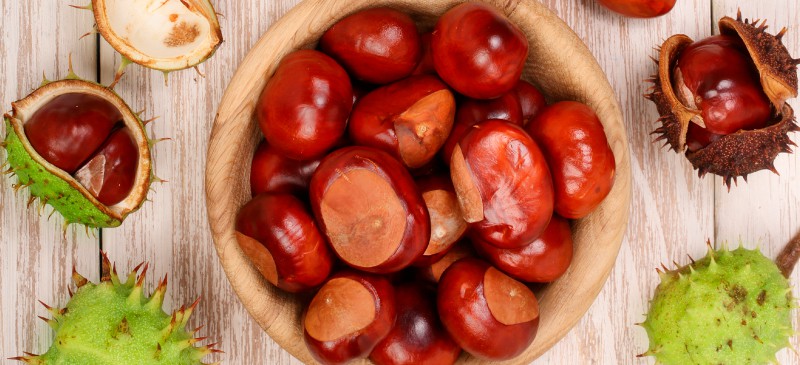
As the temperature starts to plummet and the snowflakes start falling, there’s nothing more comforting than picking up a tantalizing roasted chestnut treat from the local street vendor.
If you’re like most, you’re probably pretty familiar with this traditional holiday staple. From Christmas and Thanksgiving dinners to holiday songs, chestnuts — roasted chestnuts, in particular — are an integral part of the winter season.
Did you know that these delicious nuts can actually be pretty good for you too?
Slightly sweet with just the right amount of crunch, chestnuts are versatile, delicious, nutrient-dense foods.
Chestnuts, or Castanea, are a group of approximately eight or nine trees and shrubs that belong to the same family as oak and beech trees. These chestnut trees produce an edible nut, commonly referred to as the chestnut, which is consumed around the world.
Interestingly enough, the chestnut is considered both a nut and a fruit. This is because fruits are technically defined as the product of a flowering plant, and most nuts fall into this category.
They have a mildly sweet taste and make a good addition to a variety of dishes. Raw chestnuts have a very hard, crunchy texture that gets softer after being cooked or roasted.
The main types of chestnuts include:
- American chestnut
- sweet chestnut (also called Spanish chestnut)
- Chinese chestnut
- Japanese/Korean chestnut
Keep in mind that these types of chestnut are not related to the water chestnuts, which are not technically nuts, but are actually a type of aquatic vegetable used in many Asian cuisines. Similarly, the horse chestnut is also part of another family of plants unrelated to chestnuts, and although its extract is used as a natural remedy, it’s actually considered to be toxic.
From improving digestion to strengthening your bones and helping maintain healthy blood sugar levels, the benefits of chestnuts are vast, and there are plenty of reasons to roast them by the open fire all year round.
Benefits of Chestnuts
1. Improve Digestion
Some research has shown that chestnuts could help promote better digestion in a few different ways.
A test-tube study in the journal Food Microbiology found that chestnut extract had a protective effect on the strain of probiotics found in your gastrointestinal tract. Probiotics are a type of beneficial bacteria that keep your gut healthy and help improve digestion.
Additionally, chestnuts are high in fiber. Dietary fiber resists digestion as it passes through the gastrointestinal tract, which aids in the movement of foods through your digestive tract.
Fiber can also alleviate constipation, promote satiety, stabilize blood sugar and help nourish the beneficial bacteria found in your gut.
2. Contain Antioxidants
In addition to being a good source of vitamins and minerals, chestnuts also boast a good amount of antioxidants, including tannins, alkaloids, lutein, ellagic acid and gallic acid.
A 2010 study conducted by the Department of Biotechnology at Chosun University in Korea demonstrated that chestnut flower extract exhibited potent antioxidant properties and even helped protect against damage from melanoma.
Antioxidants are substances that help neutralize harmful free radicals, which are compounds that can build up and cause damage to cells as well as chronic disease. Studies indicate that these beneficial substances are associated with an impressive set of health benefits, from preventing cancer to fighting heart disease.
There’s also research suggesting that some antioxidants found in chestnuts, such as ellagic acid, may reduce the risk of diabetes by controlling blood sugar levels and enhancing insulin balance.
Antioxidants are found in a wide array of whole foods and are especially high in fruits and vegetables. Filling your plate with antioxidant-rich foods, like chestnuts, may be especially beneficial in reducing the risk of disease.
3. Protect Your Heart
Interestingly enough, certain types of chestnuts have actually been shown to have a protective effect on your heart. This is partially because chestnuts contain antioxidants, which can reduce inflammation and improve heart health.
Chestnuts also contain potassium, an important mineral that could decrease some of the risk factors associated with heart disease. One review found that increased potassium intake could effectively lower blood pressure and even slash the risk of stroke by 24 percent.
If you suffer from heart problems, including a serving of chestnuts in your diet may be able to help reduce some of the risk factors of heart disease and keep your heart healthy.

4. Promote Regularity
When you eat fiber, it moves through your body undigested. This can help add bulk to stool and ease its passage through the body to fight off constipation.
One analysis published in the World Journal of Gastroenterology in 2012 looked at five studies measuring the effects of dietary fiber. Researchers found that increasing fiber intake was associated with an increase in stool frequency.
Chestnuts, in combination with other high-fiber foods — such as fruits, vegetables and legumes — can be an excellent dietary addition to help prevent constipation and promote regularity.
5. Boost Bone Health
Just 10 kernels of chestnuts manage to cram in 50 percent of the manganese you need for the entire day. This is an incredibly important mineral that is necessary for normal cell function.
READ RELATED: Are Omicron Symptoms Different From Other COVID-19 Variants?
Some studies have also shown that manganese could play a central role in bone health as well and may provide protection from certain diseases.
Research indicates that approximately 43 percent of manganese is stored in the bones. Taking the nutrient in combination with other bone-building minerals may help prevent bone loss, especially in older women.
In a 2004 study, a capsule containing manganese along with vitamin D, calcium, magnesium, zinc and boron was found to increase bone density in 334 women with weak bones.
Including a serving of chestnuts in your diet, along with other bone-enhancing nutrients, could help keep your bones strong and ward off osteoporosis.
6. Improve Brain Function
Chestnuts are plentiful in several B vitamins, including thiamine, vitamin B6, riboflavin and folate. These vitamins are essential to keeping your brain healthy and protecting against disease.
Deficiencies in any of these B vitamins can cause problems with cognition. Thiamine deficiency, for example, can lead to delirium while a folate deficiency can impair brain development in children, research shows.
A 2016 study supplemented elderly participants with folic acid for one year and found that it helped improve cognitive performance while also reducing levels of certain markers of inflammation. Another study in Nutrition Journal showed that increased B vitamin intake was positively associated with cognitive function in elderly participants with mild cognitive impairment and Alzheimer’s disease.
To make sure you’re meeting your B vitamin needs and help optimize brain health, eat plenty of protein-rich foods, and consider adding a serving or two of chestnuts each day.
Chestnut Nutrition Facts
Chestnuts pack in a hearty serving of fiber, along with high levels of several micronutrients, such as vitamin C, vitamin B6 and thiamine. They are also a good source of protein and have impressive nutrition levels compared to other nuts.
Ten kernels (about 84 grams) of roasted chestnuts contain approximately:
- 206 calories
- 44.5 grams carbohydrates
- 2.7 grams protein
- 1.8 grams fat
- 4.3 grams fiber
- 1 milligram manganese (50 percent DV)
- 21.8 milligrams vitamin C (36 percent DV)
- 0.4 milligram vitamin B6 (21 percent DV)
- 0.4 milligram copper (21 percent DV)
- 58.8 micrograms folate (15 percent DV)
- 0.2 milligram thiamine (14 percent DV)
- 497 milligrams potassium (14 percent DV)
- 0.1 milligram riboflavin (9 percent DV)
- 89.9 milligrams phosphorus (9 percent DV)
- 6.6 micrograms vitamin K (8 percent DV)
- 27.7 milligrams magnesium (7 percent DV)
- 1.1 milligrams niacin (6 percent DV)
- 0.5 milligram pantothenic acid (5 percent DV)
- 0.8 milligram iron (4 percent DV)
- 0.5 milligram zinc (3 percent DV)
How do the health benefits of chestnuts and nutrient levels compare to other nuts? Chestnuts are a starchy type of nut, which sets them apart from other nuts that have a higher content of oil and fat.
Walnuts, for example, are especially rich in healthy omega-3 fatty acids. Similar to chestnuts, they are also high in manganese and copper but with lower amounts of potassium, vitamin C and vitamin B6.
Meanwhile, almonds are loaded with vitamin E and protein and contain a good amount of magnesium and riboflavin.
Other types of nuts aren’t as nutrient-dense, like peanuts, which are high in omega-6 fatty acids but low in most other micronutrients.
How to Eat
Roasted chestnuts are one of the most popular chestnut varieties and a sweet and flavorful way to add these delicious nuts to your diet.
Here is an easy way that you can enjoy your favorite street vendor snack and start chestnut roasting from the comfort of your own kitchen:
- Start with fresh chestnuts, and use a small knife to cut an “X” into each. This allows the steam to escape and prevents the chestnuts from bursting in the oven.
- Layer the chestnuts in a single layer on a baking sheet, and roast for 20–30 minutes at 425 degrees Fahrenheit. You’ll know the chestnuts are cooked when the shells crack open and they have turned a golden brown color.
- Remove from the oven, and allow to cool for a few minutes. Peel while they are still warm, and enjoy!
If you’re looking for a few other interesting ways to enjoy this sweet snack, you can also try adding cooked chestnuts to desserts, stews and casseroles for a bit of extra crunch and flavor.
Chestnut flour, made from ground chestnuts, is a gluten-free flour that can be used to make breads, pancakes and baked goods.
Remember that chestnuts need to be cooked before they can be eaten. Not only does this help remove the shell of the chestnut, but it also lowers the tannic acid content.
Research shows that tannic acid is a plant compound that has been linked to numerous adverse effects on health and should be avoided.
For more ideas of how to eat chestnuts, here are a few chestnut recipes that you can give a try:
Risks and Side Effects
Allergies to chestnuts are not as common as other types of nuts, like peanuts, but can cause severe symptoms. If you have a tree nut allergy, you should avoid chestnuts.
An allergy to chestnuts can cause symptoms like itching, swelling, wheezing and redness. If you experience any of these symptoms after eating chestnuts, you should discontinue use and consult with your doctor immediately.
Additionally, while chestnuts are an excellent source of many important nutrients, they are also high in carbohydrates. In fact, just 10 kernels provide nearly 45 grams of carbohydrates.
If you have diabetes or high blood sugar, you should be especially mindful about including chestnuts in your diet. Chestnuts are considered a complex carbohydrate, meaning they are digested slower than other types of carbohydrates, and can absolutely fit into a healthy diet.
Still, it’s best to keep intake in moderation and pair them with other low-carb options to prevent increases in blood sugar.
Conclusion
- Chestnuts should be more than just a favorite treat when Christmas rolls around. These flavorful nuts squeeze tons of fiber, vitamins and minerals into each serving, making them an ideal snack all year round.
- In addition to their stellar nutrient profile, chestnuts have also been associated with a handful of health benefits. From keeping your bones strong and fighting free radicals to supporting digestive health and protecting your heart from damage and disease, chestnuts can make a major impact on your overall well-being.
- Best of all, chestnuts are extremely versatile and easy to use. Roast them up for a sweet snack, or use them to give your next hot bowl of soup an easy upgrade. Not only are these nuts rich in flavor, but they’re also rich in nutrition and can be a healthy addition to your plate.
Source:








